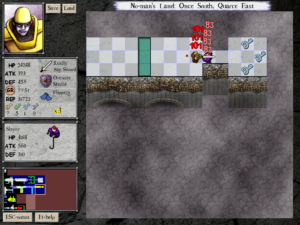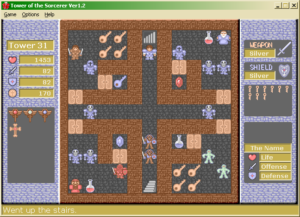I’m several days late now at posting about my initial experiences with the next game on the Stack. I do in fact have experiences to post about, but that’s not what I’m talking about today. Instead, an interlude. I’ve been spending a lot of time this week on Desktop Dungeons, and have a few things to get off my chest before moving on.
DD seems to be most commonly described as a “ten-minute Nethack“, but I disagree on both counts. First of all, I find that my typical session takes about a half an hour. At first I thought that I was taking so long because I was unfamiliar with the game mechanics. But honestly, that’s going to be the case in most sessions here, at least if you play it like I do. Completing a session successfully tends to change the game enough that I have to relearn it, whether by unleashing new monsters or map types that require new tactics, or by unlocking new character classes that also require new tactics. And some of those unlockable classes defy anticipation. Yes, you start off with the D&D-standard four choices (fighter, thief, priest, wizard), but then you get a class that specializes in destroying walls, or one that regains health from the bloodsplots left behind when you kill a monster (something that had been purely cosmetic up to that point). It reminds me a lot of the Final Fantasy V “Jobs” system, in that I’m constantly trying out new character abilities without any sense of prolonged commitment. I find there’s not much point in revisiting a class/map combination that I’ve already completed successfully, so I’m pretty much always playing from a new angle.
Secondly, the Nethack influence is pretty slim. It’s a dungeon crawl with a randomly-generated map which starts off dark and gets filled in as you explore it. This puts it into the same general category of games as Nethack, but that’s a pretty big category — with just those criteria, we probably haven’t even narrowed it down to roguelikes. A couple of stronger influences are mentioned on the game’s download page: Tower of the Sorcer and Oasis.
From Tower of the Sorcerer, we get the stationary monsters and deterministic combat mechanics, also seen in DROD RPG. (Actually, there can be a certain amount of randomness in combat: one of the special abilities of the Rogue class is a random chance of dodging and avoiding a blow completely. But most of the time, it’s deterministic.) This scheme is done in the context of randomized maps rather than authored puzzles here, but it still has the same effect on gameplay: it lets you choose your battles carefully. Also like those other games, the UI provides you with some help: hovering the cursor over a monster gives a report of its stats and what the outcome will be if you hit it — usually “Victory”, “Death”, or “Safe” (which means that neither you nor the monster will die). This is valuable information in special conditions where the math isn’t entirely obvious — for example, when playing a Berserker, you do 30% extra damage when fighting a monster of a nominally greater experience level than your character, but it’s not obvious how that fraction gets rounded, and a single point can make the difference between victory and defeat, so it’s good that the UI confirms this. It would be nice if it went further, though: the hover text only covers the next blow, and doesn’t cover things like the fireballs you plan on throwing in beforehand (and which you don’t want to waste if they’re not going to do enough damage). So I still spent a lot of the game doing mental arithmetic.
Oasis provided some basic overall inspiration for the game: it occupies a similar niche, being the “ten-minute Civilization“. It also clearly inspired the mechanics behind exploring the dungeon. To start with, movement is instantaneous — it’s exploration that takes time. You move to a spot simply by clicking on it, and if you don’t reveal any new territory in the process, no time passes. Mind you, “time” means something different here than in Oasis. Oasis had a limit on the number of turns you could take, and repositioning yourself on the map didn’t take a turn, because it basically didn’t do anything — the whole notion that you occupied a location on the map at all was purely aesthetic, with no effect on gameplay. In DD, your location is sometimes significant: if you use the teleport spell, you can wind up with multiple explored patches, islands in the unrevealed darkness, and you can’t move directly from one such island to another until you’ve explored enough to find a route.
Now, when you add newly-revealed tiles to the map, the time spent lets you (and any wounded monsters) heal and regain mana. This is very similar in feel to the way that exploring new area harvests resources in Oasis, right down to the graphical effects that illustrate the resources floating from the revealed tile to the appropriate bins in the UI. But it’s very different strategically. In Oasis, your only motivation for leaving things unexplored is time contraints. DD has no time limit, but does limit how much health and mana you can have at any given time. You can only reap an unexplored tile’s bounty once, so if you’re already at max, exploring new territory is a waste. Darkness is a resource to be hoarded.
And that’s in tension with the player’s need to explore for upgrades and, more importantly, for information. Getting a spell glyph can be important enough to burn some darkness. On encountering a shop, you want to know if it’s worth spending all your cash immediately or if there’s a better shop somewhere, and the only way to find out is to go and look for another shop. Finding an altar can be of paramount importance, and is probably the single biggest thing behind the early push to explore. Once you find one, you can declare allegiance to its god, who then rewards you with additional power of some sort in exchange for accepting some kind of limitation. For example, there’s a god of magic that increases your mana limit, but forbids you to use melee attacks — which is not a bad tradeoff if you’re playing a primary spellcaster. Typically, the reward for worshiping a god increases with the number of monsters you fight by the god’s rules, while the limitation remains constant. Thus, you ideally want to find an altar before starting to fight monsters at all. But you can waste a lot of darkness looking for one — there are typically about three per dungeon, but they’re selected at random from a larger set, and you don’t always get an opportunity to worship the god you want.
All of which is to say that this is a game that, despite its familiar framework, has interesting rules that create varied gameplay, in which I have to keep learning and figuring things out. It’s so nice to see something like this after what I’ve been playing for the last month and a half.
 Comments(4)
Comments(4)
